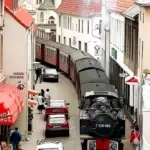Nestled in the Gulf of Finland, near Saint Petersburg, Russia, Fort Kronshlot is a historic fortification that has stood the test of time as a monument to military strategy, engineering, and cultural heritage. Built in the early 18th century under the orders of Tsar Peter the Great, this iconic structure played a pivotal role in safeguarding the maritime entrance to Saint Petersburg, the then-new capital of the Russian Empire.

The Origins of Fort Kronshlot
Fort Kronshlot was conceived in 1704, during a period when Russia was rapidly expanding its influence under Peter the Great. The fort was strategically located to protect Saint Petersburg, a city that served as the empire’s gateway to Europe and a symbol of Russia’s modernization efforts. Peter envisioned Fort Kronshlot as a stronghold that would deter naval invasions and secure the Gulf of Finland, a region of immense geopolitical importance.
Design and Architecture
The fort’s design is a testament to the military engineering of its time. Built in a pentagonal style, Fort Kronshlot features robust walls, deep pits, and strategically positioned defenses that give it a formidable appearance. The pentagonal layout was specifically chosen to enhance the fort’s ability to withstand attacks from multiple directions.
Constructed on an artificial island, the fort’s foundation involved extensive land reclamation and the use of granite and stone to ensure durability against both enemy fire and the harsh maritime climate.

Military Significance
From its inception, Fort Kronshlot served as a strategic military bastion. It played a critical role in protecting the coast and withstanding enemy advances during conflicts. Its location allowed Russian forces to monitor and control naval activity in the Gulf of Finland, ensuring the security of Saint Petersburg and its surrounding areas.
As warfare evolved, the fort underwent several upgrades to accommodate advancements in artillery and coastal defense. These enhancements included the installation of modern cannons, reinforced walls, and improved facilities for the stationed troops.
Modernization and Transformation
Over the centuries, Fort Kronshlot adapted to changing military needs. By the 19th and early 20th centuries, it was no longer the primary line of defense for Saint Petersburg, as newer forts and technologies were introduced. Despite this, its historical and symbolic value remained intact.
In recent years, Fort Kronshlot has ceased to serve active military functions. Instead, it has been preserved as a historic and cultural site, drawing visitors who are intrigued by its architectural grandeur and historical significance.
Cultural and Historical Legacy
Fort Kronshlot stands as a powerful reminder of Russia’s naval heritage and the vision of Peter the Great. It has become a popular destination for history enthusiasts, tourists, and researchers eager to explore its storied past and unique design.
Like Us on Facebook!
The fort also holds cultural importance, symbolizing Russia’s efforts to secure its place as a European maritime power during the 18th century. Its preservation serves as a tribute to the craftsmanship and strategic foresight that went into its creation.
Subscribe Us on YouTube!
Visiting Fort Kronshlot
Today, visitors to Saint Petersburg can experience the grandeur of Fort Kronshlot by taking guided tours that explore its intricate architecture, defensive structures, and historical artifacts. The surrounding Gulf of Finland offers picturesque views, making it a perfect blend of history and natural beauty.
Conclusion
Fort Kronshlot is more than just a relic of the past—it is a testament to Russia’s resilience, ambition, and strategic prowess. From its role as a military stronghold to its transformation into a cultural landmark, this 18th-century marvel continues to captivate and inspire. As a symbol of Peter the Great’s vision and the enduring spirit of Russian engineering, Fort Kronshlot remains a must-see destination for those seeking to understand the rich history of Saint Petersburg and its maritime defenses.



















